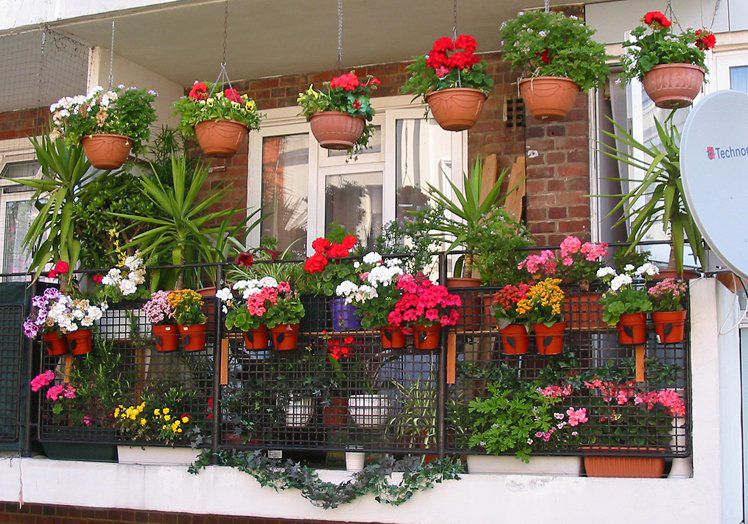Ampielnaya plants - a great way to decorate the balcony, loggia, gazebo and other structures near the house or in the apartment. Plants that flow from pots or pots to a bright flowering waterfall, always attract attention, create a sense of celebration. Ivy geranium or pelargonium is a beautiful and bright plant, which is popular for unpretentiousness, violent and long-term flowering, the ability to grow quickly. Most often, geraniums are planted on open loggias or terraces in hanging pots or pots.
Ivy geranium (pelargonium) refers to the ampelous species of plants, which are capable of producing rather long shoots hanging down from the flowerpots, or curling along the wall. In ordinary geranium shoots are short, the leaves are large and rather fragile. In ampelous species of geranium shoots are quite strong, flexible, able to withstand the weight of leaves and a large number of flowers. The leaves of the ampelous species of geranium are five-pointed, large, smooth, with a matte sheen, without a gun on the surface. In shape, they are very similar to ivy leaves, which loves to curl on vertical surfaces.
Ivy geranium flowers are always bright, large, mahristye. They are the most important decoration of the plant. Very often, the flowers are collected in large inflorescences on the top of the shoot, which gives the flowering plant the appearance of a fluffy multicolored cloud. Some growers planted beside in one box or pots at once several varieties of ivy-like geranium with different colors of flowers. This allows you to create a real color extravaganza and unusually decorate the loggia or balcony.
The most popular varieties of ampelous ileum geranium. Table
| Name | Description |
|---|---|
| Ideal for cultivation on the balcony. Flowers are large, double, gathered in bright inflorescences. Shoots grow rapidly, forming a lush basket. The basic colors of the variety are bright crimson, purple, dark pink. | |
| This variety is distinguished by the unusual color of the leaves: on the green field there are bright golden streaks. The flowers are semi-double, painted in coral or purple color, collected in large inflorescences. During the growing season, the plant quickly forms a compact basket. | |
| This variety resembles roses because of strongly terry large inflorescences. The petals of the flowers of this variety are white geraniums. The plant forms a compact bush, which is abundantly covered with beautiful white flowers. | |
| Another variety that impresses with its abundant flowering. Flowers are white, double, with a large number of petals. The bushes are large due to the abundant branching of the shoots. The highlight of this variety is that in the open sunshine snow-white petals eventually acquire a pink or purple hue, which looks very unusual. | |
| This variety amazes with its abundant flowering and beauty. Large terry flowers are always collected in large inflorescences. When flowering, the geranium bush resembles a lacy cloud, which may be pink or light lilac. Plants are unpretentious and are distinguished by the rapid branching of the shoots and the formation of a large basket. | |
| Flowers in this variety have a bright and unusual color: white, large petals are surrounded by rich crimson border. This variety of geranium belongs to the compact, as the height of the bush does not exceed 25-30 cm. It is very abundant in bloom, unpretentious to watering. | |
| The variety has a compact bush, which is densely dotted with bright purple flowers. The top petals of each flower are decorated with purple veins. The grade differs in violent flowering even in winter time, unpretentious. | |
| This variety is distinguished by very large and fluffy flowers, the upper petals of which have more intense color than the lower ones. Most often flowers of this grade are painted in saturated and claret color. Differs abundant flowering, large bushes with wide glossy leaves and branchy shoots. | |
| The flowers of this variety are colored geraniums in a bright red color, strongly furry, with large petals. The bush is quite compact, not too tall. The leaves are green, spotless, internodes on the shoots are short. | |
| Petals of flowers of this variety have the richest color among all types of geraniums - dark maroon. The variety has a rich flowering bush forms a compact lush basket. The leaves are green with a glossy shine. without spotting. |
It is important to know! Ivy geranium grows very fast. In just a few weeks, the plant grows several times, but the root system develops well and functions even in small pots. If the capacity is too small and the roots do not have enough space, the flowering plant can shed its inflorescences and slow the growth.
Planting Ivy Geranium Seeds
Ivy geranium can be sown at any time of the year, if you want to dissolve this beauty on the window sills in the apartment. If you want to decorate with a plentiful and beautiful buds in a planter a balcony or a private plot, then it is advisable to sow the seeds in the spring in order to transplant the grown and grown plants to the flower beds by early summer.
Seed preparation
The seeds of this plant species are quite large, with a strong and reliable shell. In order to increase germination, seed material should be prepared a few days before planting. The first thing to do is slightly thin the thick seed coat. For this purpose, any sharp or abrasive material is used. You can slightly cut the surface of the seeds with a regular nail file, fine sandpaper will also work. This should be done carefully, so as not to damage the seed inside the shell.
After scarification (the so-called thinning of the seed coat), the seed should be soaked in water. Ideally, it is best to use melt water, but if not, then boiled liquid will do.
Seeds in cooled to room temperature water soaked for a day. The last stage of seed preparation for planting is disinfection. You should put the seeds in a weak solution of potassium permanganate for half an hour. After this procedure, the seeds are removed from the disinfectant solution and placed on a clean cloth for drying.
While the seeds are soaking, prepare the containers with the soil. You can use ready-made soil, which is sold in specialized stores, peat pots, or make a soil mix yourself. The composition of the soil in equal quantities should include peat, sand and sod land. Homemade soil before planting seeds is desirable to disinfect with a weak solution of potassium permanganate.
Planting seeds
Seed the seeds into the ground to a depth of no more than 5 mm. Before planting, the soil should be well moistened.
After the planting procedure, the seed containers are covered with cellophane and placed in a warm place where the air temperature does not fall below 22 degrees.
Watering seeds should be carried out in 5-6 days. In order not to erode the soil with the planted material, it is recommended to spray water with a spray bottle. It is also important to periodically air containers with seeds, opening the film for several hours.
Video - Planting Geranium Seeds (Pelargonium) Ivy in a Snail
Seedling care
Seedlings with geraniums germinate very quickly, literally within 10-14 days. 3 weeks after the appearance of the first leaflets of the seedlings, the plants can be transplanted into separate flowerpots. It is necessary to stop seedlings with extreme caution, the root system of flowers is quite fragile and can be damaged by rough handling, which will immediately affect the vegetation of plants. It is best to transplant plants with a lump of earth, it will save the roots.
Young plants two weeks after transplantation is recommended to feed. For normal growing season, nitrogen fertilizers are used, which should be applied under the root.
Sprouts of ivy geranium need a fairly long light day - at least 12 hours. Therefore, if the seeds germinated in February or March, the plants should be provided with additional lighting.
If plants are transplanted into pots or containers in which they will grow continuously, you should know that at least one liter of soil is required for one seedling. The distance between plants should be at least 15-17 cm. With proper care, the basket of geraniums will grow and fill up all the free space in the pot or box. Also be sure to make a drainage at the bottom of the tank, through which all excess moisture will go. If the ivy geranium will later be transplanted into open ground, the volume of the temporary pot is not so important.
The seedlings that are intended for growing on the street should be constantly hardened. For these purposes, pots of plants in warm weather in late April - early May should be carried out on the street, gradually increasing the interval of time spent in the fresh air.
Ivy Pelargonium - outdoor cultivation
Ivy Pelargonium - outdoor cultivation
Choice of place
This geranium variety needs constant and intense illumination. The plant easily tolerates the sun and the lack of moisture, in abundant watering and shade have a bad effect on the growing season and budding plants. Planted grown and hardened geranium seedlings are best in well-lit places, so that the plants are provided with constant sunbathing.
The soil
Geranium grows well on light and lean soils. The green part of the plants grows well on nutrient substrates, but the flowering becomes very moderate. You also need to pay attention to the acidity of the earth, for ivy geranium suitable soil with indicators of 6.0 - 6.5 pH. At lower or higher rates in plants, root nutrition is impaired, which affects the growth and budding of the culture. To ensure the desired acidity, you should periodically update the soil near the roots of plants. Soil with optimum acidity can be purchased in special stores.
Top dressing
In the period of growth and budding, Ileum geranium needs periodic dressings in 10-12 days. You can use ready-made fertilizers for flowering plants: “Biomaster”, “Kemira-lux”, “Pelargovit”. Planting should be done according to the instructions.
You can also feed the plants homemade fertilizers. For example, using onion peel. For a large number of flowers, the infusion is prepared as follows: in 5 liters of boiling water, you need to brew 2 large handfuls of onion peels. Infusion should be stretched for 2 days. Next, 1.5 liters of fertilizer bred in a bucket of clean water and watered with this mixture of existing bushes of plants.
Watering
Ivy geranium needs abundant watering, but overflow can have a detrimental effect on the vegetation of plants. Waterlogging can trigger a number of diseases that can be seen visually. These include edema, which is expressed in the appearance of nodules and scars on the green leaves of geranium.
To get rid of this disease can only adjust the mode of watering and drying. The most important rule for watering is to saturate the plants with moisture only when the basal earthen room is completely dried. Therefore, before each irrigation should carefully check the soil.
Balcony plants placed on the sunny side can be additionally sprayed with water, but only in the evening, when direct sunlight will not be so intense.
Wintering Ivy Geranium or how to preserve perennials
Ivy geranium is a perennial plant that tolerates wintering well in southern latitudes at a temperature of 10-12 degrees. But what to do if the average winter temperature is very low and the soil freezes through completely.
Plants can try to preserve for the winter, in the spring to plant again in the ground. To do this, in the fall, completely cut off all the shoots from the geranium bush and carefully dig up the roots with a large lump of earth. Clod should be placed in a transparent plastic bag and additionally sprinkled with earth. Place the package should be in a lit place with air temperature not higher than 7-8 degrees. It can be a warmed balcony, a glazed loggia. Watering dug cuttings is not necessary.
In the spring, cuttings with roots are transplanted to the old place and after a while the geranium will give new shoots.
Plants that grow in pots, you can not cut. For the winter, it’s enough to move them to an apartment and place them on well-lit window-sills.
Those plants that winter in the apartment need pruning, so that by spring a beautiful and even basket of shoots will form. Trimming is carried out in the winter - in December-January or in the spring - in March.
With the help of the pruner, all strongly stretched shoots are cut so that a compact bush is formed. Pruning will start the growth of lateral shoots and because of this after a while the plant will become thick.
Clipped shoots do not need to throw away - you can try to germinate in the ground.
Video - Spring pruning of Ivy Geranium and planting cuttings
Ivy Pelargonium: visual cues for help
- If the geranium leaves turn yellow around the edges, it means the plant lacks moisture.
- If rot or yellow spots appear all over the leaf - an excess of moisture or pest infestation.
- With a lack of light from the geranium fall lower leaves.
- If flowers of white color are painted in a pink shade - too intensive sunshine, sometimes the plant should be pritenyat.
- If flowering has declined, it is recommended to tear off the old faded buds.
Grow ivy geranium on the balcony or in the garden is not too difficult. A riot of flowers and colors during the flowering period will immediately pay back all the hassle associated with growing this type of flower.
Geranium or pelargonium is a flower that has always been and will be honored by many gardeners. It is an ornamental flowering plant of the Geranium family with decorative and healing properties. In nature, this plant grows in southern Africa. Today there are many varieties of pelargonium. The most popular is considered Pelargonium ileum Tornado.
The difference between pelargonium ileum and geraniums
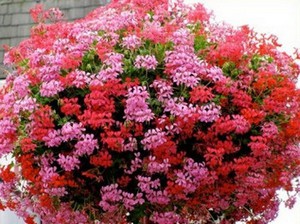 Unlike conventional geraniums, this is an ampelous annual crop. Its leaves are shaped like ivy leaves. They are quite dense and look like artificial. Many flower growers do not know what this decorative flower actually looks like. It is often confused with ordinary geraniums.
Unlike conventional geraniums, this is an ampelous annual crop. Its leaves are shaped like ivy leaves. They are quite dense and look like artificial. Many flower growers do not know what this decorative flower actually looks like. It is often confused with ordinary geraniums.
There are several features by which it is possible to distinguish ivy from the usual geranium:
- First of all, this is the name of the flower.
- This plant belongs to the group of ampelous flowers with large hanging stems. Ordinary geranium is an erect plant of low growth.
- Pelargonium ampelous tree acquires numerous flexible and climbing shoots, due to which the flower looks very impressive and beautiful. On adult specimens, the stems reach a meter height.
- Geranium has soft and very tender leaves, and ile-pelargonium has leaves that are smooth, five-lobed and with a glossy surface. Their width ranges from three to six centimeters.
- Pelargonium flowers are highly decorative.
 At home, the care of these plants is almost the same.
At home, the care of these plants is almost the same.
All varieties of Ileum Pelargonium have a long peduncle - from twelve to eighteen centimeters long. On each peduncle ornamental flowers are located, collected in umbrella inflorescences of six to eight pieces.
Pelargonium ileum Tornado, as well as geranium, is valued for its simplicity in the care, duration and brightness of flowering. Decorative qualities have not only flowers, but also the leaves of the plant.
How to care for ampelous pelargonium for lush flowering?
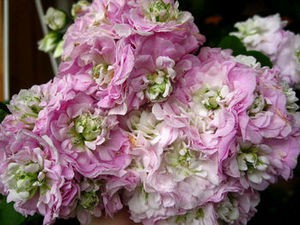 Despite the fact that the care of this flower is simple, there are some features that should be considered in the process of its cultivation.
Despite the fact that the care of this flower is simple, there are some features that should be considered in the process of its cultivation.
To achieve a long and lush flowering, ileum pelargonium must be planted in good soil. The full development of this flower will depend on the quality and composition of the soil. It requires nutrient soil and a small capacity for planting. Ileum Pelargonium, as well as geranium, refers to the indoor colors that love to grow in cramped. The diameter of the pot should be a couple of centimeters larger than the diameter of the root system.
Nutritional mixture for planting pelargonium can be prepared at home. To do this, you need sand, humus, sheet, peat and sod land in equal parts. All components are thoroughly mixed.
In addition, you need to know other requirements in the care of this flower:
Breeding
This flower is very easy to propagate at home. Reproduction of pelargonium, as well as geraniums, occurs in two ways: using seeds and cuttings.
Seeds
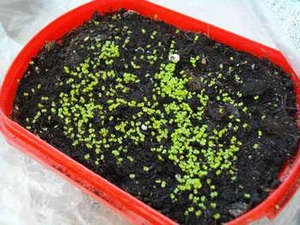 Seed propagation is a very laborious and laborious process that requires knowledge and skills. Planting seeds is carried out in the period from the end of winter to the middle of spring. Additional lighting is the most important condition for the full development of seeds and seedling germination. Seeding is done up to one centimeter deep. After that, the seedlings are abundantly moistened with a spray bottle and placed in a warm place.
Seed propagation is a very laborious and laborious process that requires knowledge and skills. Planting seeds is carried out in the period from the end of winter to the middle of spring. Additional lighting is the most important condition for the full development of seeds and seedling germination. Seeding is done up to one centimeter deep. After that, the seedlings are abundantly moistened with a spray bottle and placed in a warm place.
Subsequent maintenance of the planting is to ensure a stable temperature regime within twenty-two to twenty-five degrees and a long daylight. In such conditions, seedlings will germinate very quickly - in seven to ten days. Watering sprouted seedlings should be moderate, avoiding overflows and stagnant water, as well as drying out the soil. After about three to four weeks, when the pelargonium ileum grows and is strong, they are transplanted. After transplantation, seedlings are given time to adapt, then fertilized for the first time using complex mineral fertilizers. Growing pelargonium from seed is a fascinating process that requires attention and patience.
Cuttings
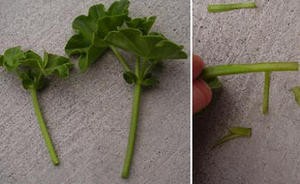 Propagation by cuttings is carried out in early spring. To do this, you need healthy and large cuttings. They are cut off, then left to dry for a day. The cut sections are treated with coal powder. After this, the shoots are planted in pre-disinfected soil, compacting well. The distance between the cuttings should be at least two centimeters.
Propagation by cuttings is carried out in early spring. To do this, you need healthy and large cuttings. They are cut off, then left to dry for a day. The cut sections are treated with coal powder. After this, the shoots are planted in pre-disinfected soil, compacting well. The distance between the cuttings should be at least two centimeters.
The reproduction of pelargonium in this way is almost always successful. One month after planting, the cuttings must root. After which they are planted in the ground. If the transplant of young plants is made in spring, then in the middle of summer you can get magnificently blooming geraniums in your garden.
Special care for these flowers is required in winter. With good and long light, the above-ground part of the plants is not cut off.
If this condition is not met, then the iridescent pelargoniums are pruned completely, leaving small hemp. Then they are placed in a cool place with a temperature not higher than ten degrees heat.
Diseases and pests
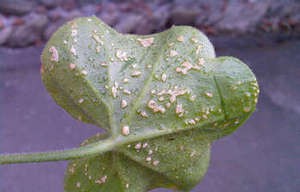 Growing in the indoor environment, that geranium, that pelargonium ileum tornado, are prone to diseases and pest invasion.
Growing in the indoor environment, that geranium, that pelargonium ileum tornado, are prone to diseases and pest invasion.
These plants love to eat slugs and caterpillars. To get rid of malicious insects can be using systemic insecticides.
In addition, these flowers are affected by flower mold, rust, viruses and blackleg. The main reason - the wrong care and conditions of detention. Treatment of diseased plants is carried out with the help of chemicals.
Add site to bookmarks
How to grow ivy geranium?
- Growing conditions and care
- Diseases and pests
- Pelargonium in the house
Geranium is a plant that is well known to each of us since childhood. But ivy geranium can surprise with its beauty even an experienced grower. It is also called ampelous: geranium shoots of this species reach 50-80 cm in length and are able to fall down the cascade downwards without breaking. In suspended pots, on the “green walls” and in vertical indoor gardens, blooming ivy-like pelargonium, as this flower is called in scientific literature, looks impressive and very unusual. Its leaves are smooth and shiny, and bright flowers differ in a variety of shades, so choosing the right one for your interior is not difficult.
Geranium (Pelargonium) Ivy is unpretentious in the care. She needs moderate watering, diffused sunlight and temperatures above 20 degrees.
Growing conditions and care
Home care for pelargonium is simple. This plant propagates by cuttings, dividing the root and seeds.
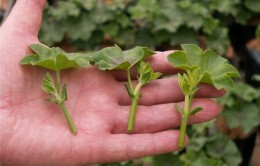
A quick way to grow geraniums is by cuttings that can be cut from an adult plant.
- Reproduction by cuttings. The upper part of the shoot with 2 leaves is cut, 1-2 cm away from the knot, lowered into the water, where you can add Kornevin. After 1-2 weeks, roots appear. The plant can be planted in the ground. You can immediately place a freshly cut sprig into wet sand and cover with a glass jar to create greenhouse conditions. But in this case, do not forget to air the cutting daily, removing the jar for 5-7 minutes. Planted rooted plant in its intended capacity can be in 3-4 weeks.
- Division of the root. When transplanting pelargonium in spring or autumn, the overgrown root is neatly divided into 2-3 parts, it is desirable that there is an escape on each of them. Parts of the plant are placed in containers with drainage mixture and light soil, which must include peat and sand. Watering, not allowing the soil to dry out, should be 1 every 2-3 days.
- Seeds. Purchase planting material in specialized stores is now very easy. This method of breeding Pelargonium is most common among gardeners who grow certain varieties of ivy geranium, because only seeds obtained from verified vendors guarantee full compliance with the varietal characteristics of pelargonium that you have chosen. Seeds are sown in containers with moistened and disinfected peat mixture, sprinkled with a thin, no more than 1 cm, layer of earth and covered with glass. Geranium is thermophilic, the temperature in the boxes with seedlings should not fall below 21 ° C. For the successful germination of seeds 1 time in 3-4 days lift the film or glass, remove condensate. The first sprouts will appear in 7-14 days. Do not expose seedling containers directly to the sun, the light should be diffused. And keep the temperature, remember that shoots can destroy even a small draft. Pelargonium is seated in separate pots when 2-3 leaves appear.

For fertilizing geraniums are used nitrogen fertilizers.
Care at home for ampelous pelargonium has one more feature: in the period after transplantation, it requires nitrogen fertilizers, but an adult plant is better once every 2-3 weeks to feed with fertilizers, which include phosphorus and potassium, which is necessary for lush flowering. The soil is also important, which should include peat, humus and sand in equal quantities.
Pelargoniums require sunlight, moderate watering, temperatures not lower than 21 ° C, and room for good shoot growth. During the flowering period, inflorescences of red, white, pink or other flowers with a slightly spicy strong odor will appear on each of them.
Among the peculiarities of the care of pelargonium there is another nuance: this ampelous plant needs the formation of a bush.
The first shoots gently directed down the pots on the walls, sometimes even attaching to the edges. Under favorable conditions, ileum Pelargonium grows very quickly, therefore, once a month, pinching of tops, removal of yellowed leaves or withered inflorescences may be required. A plant is transplanted when the root system becomes scarce in its intended capacity.
If you want to grow pelargonium as a garden plant, it should be planted in containers in February. For 2-3 months, she will be able to take root well and better tolerate climate change. You can decorate with flowers balconies and loggias, decorate arbors, place pots on the terrace. In summer, pelargonium can be planted in open ground as a carpet plant.
In the autumn, before the onset of frost, geranium need to dig and transplant in pots and pots, pruning long shoots. Overwintering plant at home. Ideal for florists is the option when pelargonium is grown in containers that are placed at home in the fall, and re-installed in the spring and fixed on your site or balcony.
With the onset of heat, the streets of cities and small towns, homestead plots and balconies are transformed by the lush flowering of a wide variety of decorative crops. Pelargonium ampella, as in the photo, with spectacular falling shoots and consisting of a dozen flowers of inflorescences is one of the first places among the plants used for gardening.
Like other types of pelargonium, the ampelnaya or ivychelischnuyu variety was first discovered in southern Africa, but the unpretentious and responsive care plant quickly gained the love of flower growers in all corners of the world.
What is ampelnaya pelargoniya
Pelargonium is often called geranium, and both of these names are associated with birds. If the first word is translated from Greek as a stork, then the second word from the same language is like a crane. Geranium is a frost-resistant plant, quietly wintering in the garden or in a flower bed. What is an ampelous amber pelargonium from the point of view of a home phytodecorator? This is a plant with which you can create unique green interiors that do not require a special flower breeding experience. They are good for so-called hanging gardens. These include ampel pelargonium ileum, the length of shoots which reaches almost one meter. It comes from the south of Africa, where it falls from the slopes of the hills. 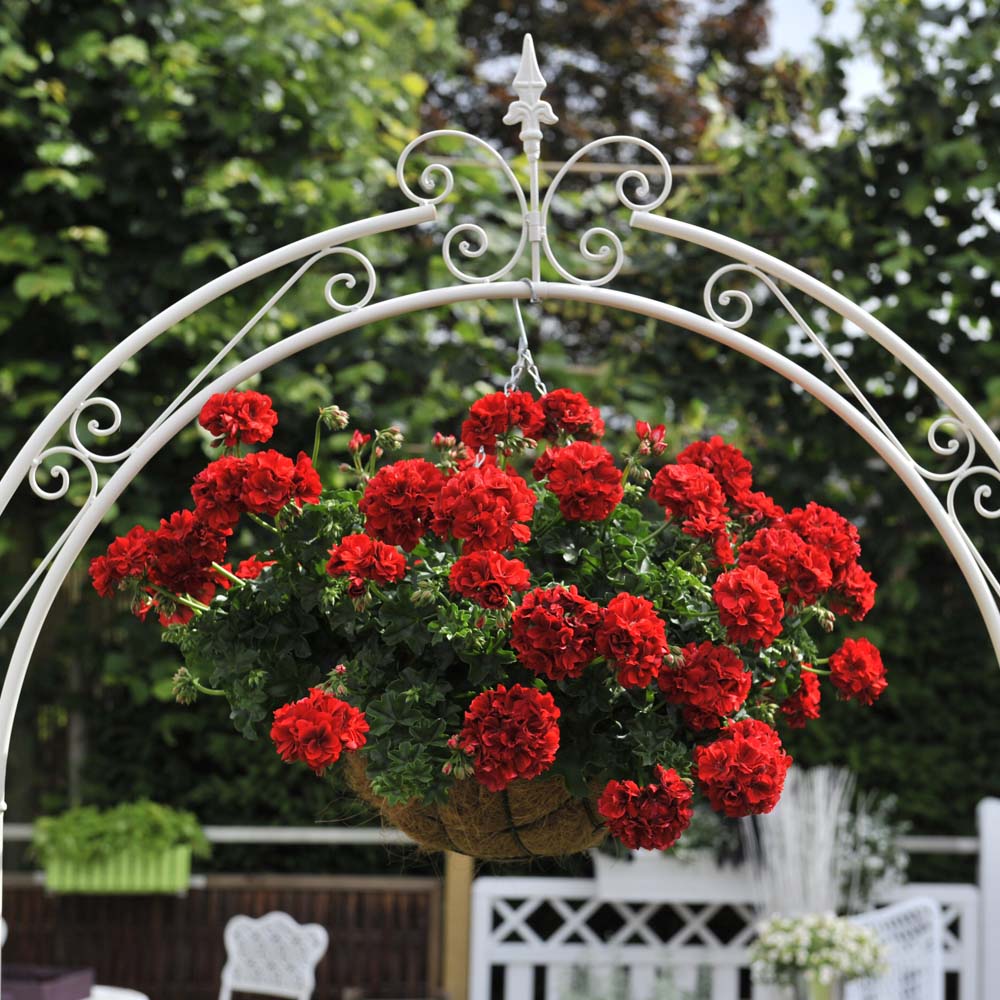
The main differences between ambernum pelargonium and ordinary geranium
Inexperienced growers often confuse ordinary geranium and ampel ampelous. This is a big mistake, because the latter has its own characteristics of care. Those who do not know them, can easily destroy the plant. So, what is the difference between ileum and pelargonium?
1. The plant has thin hanging stems that can be up to 1 m long; in ordinary geranium, the stalks are short and stand straight.
2. Around the stem of the ileum Pelargonium grows many flexible, climbing shoots. They give the plant pomp and showiness.
3. In ordinary geranium, the leaves are very soft, in the ivy-like variety, the leaves are five-lobed, smooth and even glossy. In width they can be up to 6 cm.
4. The colors of ileum pelargonium are larger and brighter.
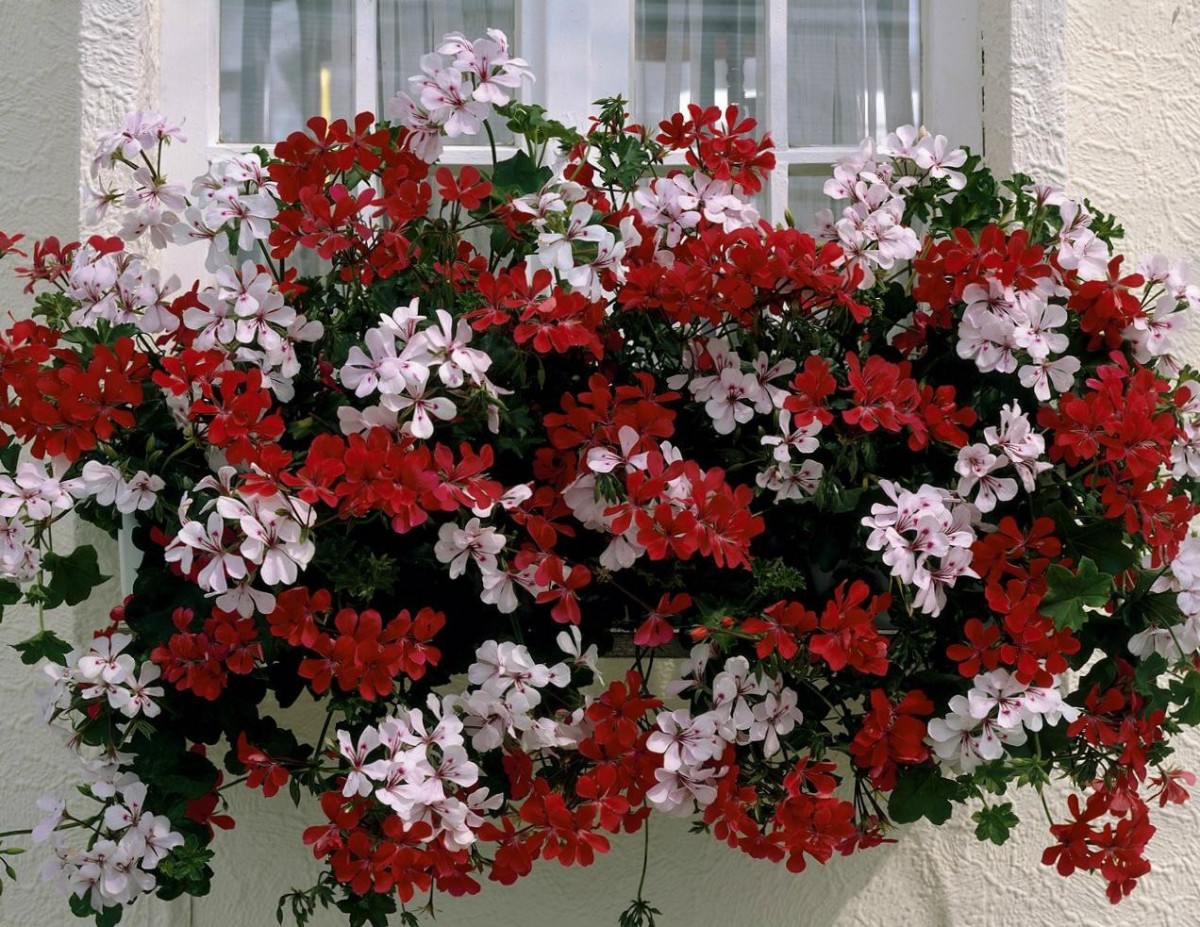 Ampel Pelargonium Varieties
Ampel Pelargonium Varieties
Today, in stores and in the markets you can buy geraniums of a wide variety of varieties, including ampelous geranium. Decorative leaves and flowers of bright and unusual shades on the window or balcony will delight not only the apartment owners themselves, but also their neighbors. Yes, and passersby are unlikely to remain indifferent.
There are many species and varieties, the most common of which is zonal pelargonium, varieties of which number several tens of thousands. This species got its name due to the so-called zones on leaves that have a different color. At the same time in winter, when the light is low, they disappear, and appear in the spring again.
There are rosaceous pelargoniums with buds similar to pink and tulip-shaped, the flowers of which resemble the buds of tulips — they were brought out by American amateur breeders in the middle of the last century. Star Pelargonium is a rare species. It is characterized by twisted flower petals. Clove varieties resemble garden carnations.
Royal geranium has large sizes and flowers with a corrugated edge. The peculiarity of its color is that it does not have uniform shades of white, burgundy, purple and pink. Variety "Angel" resembles the appearance of astermia. It was obtained by breeding in the 30s of the last century. This variety is also referred to the royal group.
Planting of ampelous pelargonium
Plant ampelous geranium in light fertile soil with excellent drainage properties. The plant grows well on neutral, acidic and slightly acid soils. Expanded clay should be placed on the bottom of the tank for quick removal of excess moisture. Plant a flower closely, it grows better this way. However, between the roots of pelargonium and the walls of the pot should remain a distance of one and a half centimeters. When grown in a pot, transplants are made every two years in the springtime. In addition, transplantation should be carried out in the event that geraniums become too closely in the tank. 
Selection of soil mixtures and fertilizing for ampelous pelargonium
In order for an ampelous geranium to please its flowering as long as possible, it is necessary to take a responsible approach to the choice of soil and feeding. It is best to prepare a mixture of peat, humus, sand, turf and leaf earth. All components are taken in the same quantity.
Since this plant is mountainous, it will require drainage. Expanded clay is ideal for this purpose.
Potash fertilizers should be purchased as top dressing. They are used every 10 days. Fertilization begins at the end of March and ends in the first half of November. Many gardeners use liquid dressings. For example, it can be iodine. So, 1 drop is added to 1 liter of water. For one time, 50 ml of this solution is sufficient. Organic fertilizers for ampel geranium are not suitable.
How to deal with pests?
It is easy to reproduce ivy geranium at home. This can be done in two ways: by seeds and cuttings. Seed method - a difficult and painstaking path. Usually it is chosen by experienced flower growers. Planted seeds in the period from February to mid-April.
- Seeds are immersed in the soil to a depth of 1 cm.
- After that, the soil is well moistened, but not from a watering can, but from a spray bottle.
- Seedlings need to provide additional lighting and clean in a warm place.
- Next, you need to carefully monitor the temperature, it should be kept in the range of 22-25 ° C.
- To plant seedlings in a permanent ground can be 3-4 weeks after sowing seeds.
Reproduction by cuttings is much easier under one condition: there is where to get these cuttings. You need to do this in early March.
- Choose healthy and large cuttings, cut them off and let them dry for a day.
- Slices carefully treat with coal powder.
- Take the disinfected soil and plant cuttings at a distance of 2 cm, well compacted soil.
- A month later, seedlings can be transplanted to a permanent ground.
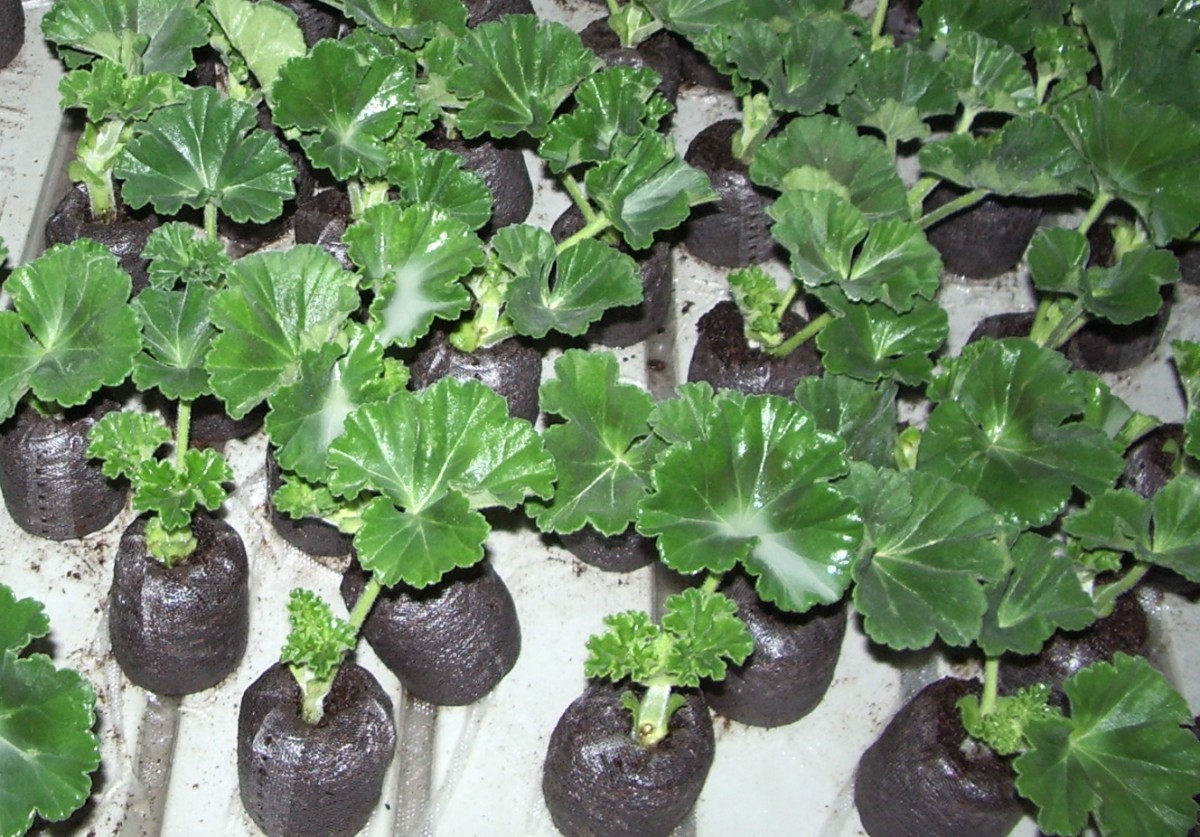 Reproduction features of ampelous pelargonium
Reproduction features of ampelous pelargonium
Geranium has a very similar analogue, which has received the name Pelargonium Ivy. Virtually every home grows or once grew geranium. It can be planted in open soil. But in this case, it should be carefully looked after.
These flowers are known to many gardeners and that is why they so often land on summer cottages. Most often, ivy-like geranium is used to decorate window sills, balconies, terraces, porches, etc. This plant can curl and fill free holes in fences and even on small enclosures. Also, experts recommend the use of this indoor climbing flower for decorating smooth surfaces. What really should be the right care for this plant?
General information
Externally, pelargonium ivy resembles the most common ivy. The main feature of this plant is a unique smooth five-blade leaves. In nature, winding stems can grow in highlands and even climb steep, rocky slopes. At home, cultivated varieties have stems 70 cm long, which are hung in a beautiful cascade from the pot.
Flowers of this plant are collected in rather large and fluffy inflorescences. On one of them you can count up to 15 flowers. Pelargonium blooms very bright and colorful. Experts say that quite often there are also spectacular terry flowers of completely different shades.
Like other related varieties, ampelous geranium loves the sun and grows well only when exposed to direct sunlight. The main advantage of geranium is its resistance to very high temperatures. In winter, however, pelargonium ampelous feels great in the room. The optimum temperature for its cultivation is 20-25ºС. If the average temperature is slightly higher, then you should produce regular watering of plants. So they survive and continue to grow and develop properly.
Sometimes the owners try to harden the plant and even at temperatures below the specified, try not to hide it in warm rooms. Naturally, geranium in this case begins to gradually adapt to new conditions. But there is still a limit. At subzero temperature, ampelous geranium simply will not survive.
Before planting the plant, you should pick up the soil. The soil must be sufficiently moisture-intensive, loose and contain all the necessary trace elements. But the overmoistened soil also should not be, as the indoor flower can spoil.
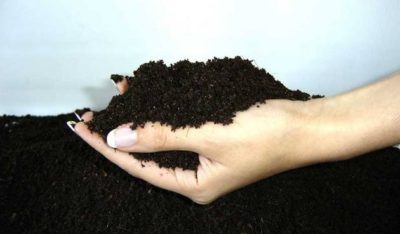
The most active plant growth begins in early March, and ends in late autumn. If ivy geranium is transplanted into a pot and placed in a warm room, it can bloom until about the middle of winter.
Well, of course, experienced gardeners recommend carefully choosing mineral fertilizers applied to the soil. If you feed the geranium with nitrogen, it will begin to grow rapidly and flourish. If time does not change the nature of feeding, the plant will stop forming new buds. Especially necessary in this case are phosphate and potash fertilizers.
Breeding symptoms
Experts in the field of growing different plants claim that in two ways: cuttings and the method of sowing ready-made seeds.
Most often, to obtain offspring using the first method of reproduction. Why it happens this way, nobody knows, because the seeds usually grow too quickly and give enough young bushes for further planting.
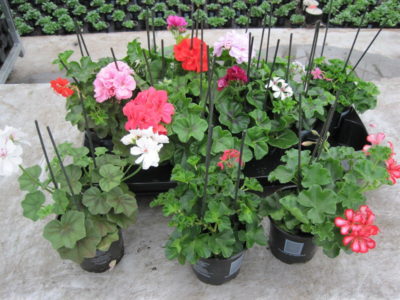
Seeds are sown, usually from November to early March. Naturally, the procedure is carried out at home. It is very important to pay attention to the lighting. Ivy geranium requires at least 12 hours of intense light, so very often the hosts connect additional light sources. In order for pelargonium to be well entrenched in the substrate and to acquire a powerful root system, it is necessary to independently prepare the soil for it. To prepare the soil you need to take 1 part of peat, sand and previously prepared turf soil. By mixing all of the above components, the ideal medium comes out for.
Planting seeds produced in pots. The seed sinks into the soil a maximum of 5 mm. Then the container is covered with cling film, which creates the so-called greenhouse effect and provides the necessary heat for the germination of geranium. Watering is done very carefully. It is best to use a spray.
Properly caring for the plant, already after 7-10 days you will receive the first shoots. When they have grown sufficiently, the ivy pelargoniums can be transplanted into separate pots or into open soil.
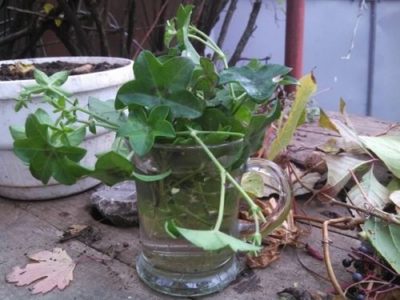
Cutting is also an easy process. Cuttings can be taken in March or in August. To obtain the necessary material should be cut off the upper part of the shoot. It is best to pick shoots with a length of 7-10 centimeters. It is very important that it has at least 2 strong leaves. Deepening shoots should not be more than 3 cm, otherwise the flower will not grow. In a month, the root system of ivy geranium strengthens. After that, you can repot the plant in larger pots and other containers. The first bloom will be only after the first wintering.
How should I care for a flower?
To ensure proper care, first of all it is necessary to choose the right soil. It depends on it whether the plant will continue to bloom and bear the desired fruit.
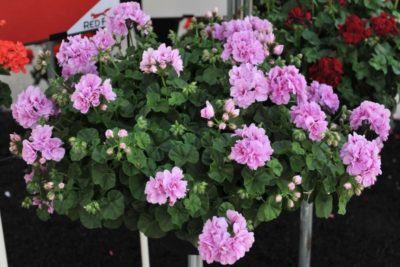
Ivy geranium is not very fastidious to the ground, but still it needs certain conditions. First of all, geranium can only function successfully in fertile soil. For its production should take the same amount of peat, simple turf land and humus. Pelargonium is not very comfortable in an overly spacious container, so professionals recommend planting a plant in small pots. The distance between the roots and the walls of the pot should be no more than 2 cm.
Caring for geraniums is not so difficult as it may seem at first glance. Since the plant is from Africa, it is very fond of the sun's warmth and light. It should be placed on well-lit window sills. If there are none, then it is better not to start pelargonium at all, since it will not live without a heat source even for a month, and will simply suffer.
Despite the fact that geranium comes from Africa, it also does not tolerate excessive heat. Air temperature should fluctuate between 20 and 25ºС. In the winter season, however, it is permissible to decrease by several degrees.
In too dry weather, it is necessary to water the plant abundantly. But there should be no stagnation of water. If moisture is excessive, mold can form, which has a detrimental effect on the plant. In order to prevent this from happening, the so-called drainage should be done, it will help to remove excess water. In cool weather, reduce the number of waterings to 1 time in 14 days.
From the foregoing, we can conclude that the maintenance and cultivation of Ile Pelargonium is an uncomplicated process. As a reward, you get the perfect plant with lush branches and bright flowers.
And a little about the secrets ...
Have you ever experienced unbearable joint pain? And you know firsthand what it is:
- the inability to move easily and comfortably;
- discomfort when climbing and descending stairs;
- unpleasant crunch, clicking not at own will;
- pain during or after exercise;
- inflammation of the joints and swelling;
- unreasonable and sometimes unbearable aching pain in the joints ...
And now answer the question: does it suit you? Is it possible to endure such pain? And how much money have you already “leaked” to ineffective treatment? That's right - it's time to stop this! Do you agree? That is why we decided to publish an exclusivean interview with Professor Dikul in which he revealed the secrets of getting rid of joint pain, arthritis and arthrosis.
